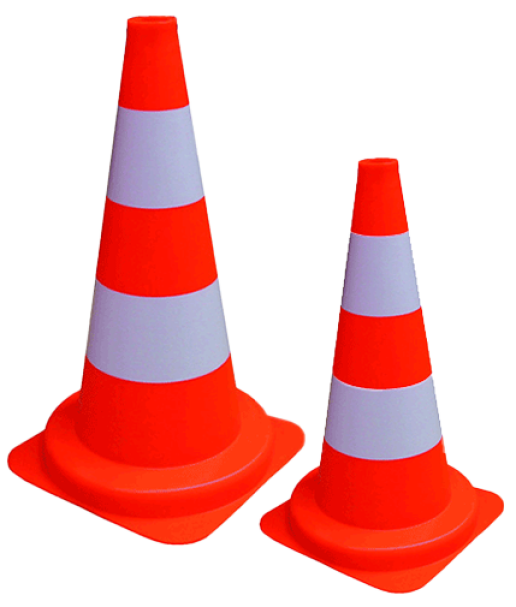An iconic cone

Before the invention of the traffic cone, wooden barriers and tripods were used to mark dangerous spots on the motorway. They were not easily visible and were often broken. They also had to be assembled for each project and were cumbersome to store.
An 80-year-old cone
Charles D. Scanlon, an American street painter employed by the city of Los Angeles, became tired of constantly repairing and repainting the traditional wooden tripod bollards and barriers. He came up with a rubber cone that could be easily seen, moved, and would right itself after being hit or damaged. This was in 1942, and thus the first traffic cone was born.
In 1943, the first patent for a traffic cone was filed with the Los Angeles Street Department. Sewn from pieces of old tyres, the "safety marker" was designed to replace rigid barricades, reducing damage to vehicles and risk to road workers.
In 1947, the rubber cone began to be mass produced and became a traffic staple!
On British roads, traffic cones were first used in 1958 when the country's first motorway, the M6, was built. A few years later, in 1961, British engineer David Morgan designed the first plastic cones.
The all-plastic orange and white cone
Today, the all-plastic cone is made mainly of PVC - increasingly recycled - with a reinforced polyethylene or rubber base (although some are also made of polypropylene). It is mainly orange and white in colour and usually has two stripes which may or may not be retroreflective depending on the location and duration of use (day or night).
It has an eye-catching shape and is stable, easy to stack and move. Another advantage is that it can be manufactured in large numbers and at low cost.
A key role in ensuring safety and visibility in hazardous areas
While it is one of the simplest safety concepts available, it is also one of the most widely used. This temporary road marking is mainly installed near construction sites or accident areas. The cones prevent road users from using a part of the road or pavement where construction or rescue operations are taking place.
They make the demarcated area visible from a distance, regardless of the weather conditions, or mark out traffic and thus protect road users by allowing them to anticipate their passage. They are placed diagonally on the road ahead of any obstacles.
Today, an estimated 140 million traffic cones are in use worldwide. They have gone beyond their role as road signs and are now found on rooftops, sports fields, race tracks and countless car parks.
From cone to icon
Beyond the simple signage object, the cone has become one of the most 'iconic' inventions of the United States and a curious subculture has developed around them and their many unorthodox and irreverent uses.
In Glasgow, Scotland, an orange and white plastic road cone has topped the equestrian statue of the Duke of Wellington for 40 years. The "man with a cone on his head" appeared one night and has become a distinctive feature and an anti-establishment icon of the city.
In Montreal, the orange cone has become a humorous symbol of the city and its perpetual roadworks. Montreal cartoonist Serge Chapleau made it into a character called "Le Cône" on the ICI Laflaque show.
Finally, the traffic cone is the icon of the iconic VLC media player, one of the most widely-used software programs in the world.





